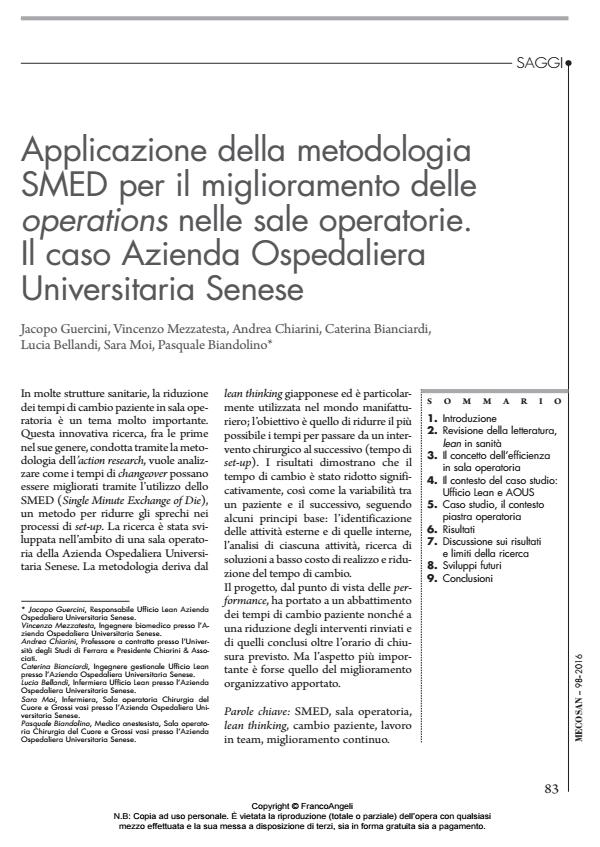Applicazione della metodologia SMED per il miglioramento delle operations nelle sale operatorie. Il caso Azienda Ospedaliera Universitaria Senese
Journal title MECOSAN
Author/s Jacopo Guercini, Vincenzo Mezzatesta, Andrea Chiarini, Caterina Bianciardi, Lucia Bellandi, Sara Moi, Pasquale Biandolino
Publishing Year 2016 Issue 2016/98
Language Italian Pages 21 P. 83-103 File size 23981 KB
DOI 10.3280/MESA2016-098005
DOI is like a bar code for intellectual property: to have more infomation
click here
Below, you can see the article first page
If you want to buy this article in PDF format, you can do it, following the instructions to buy download credits

FrancoAngeli is member of Publishers International Linking Association, Inc (PILA), a not-for-profit association which run the CrossRef service enabling links to and from online scholarly content.
Operating theatres within healthcare organisations are often affected by long changeover time of patients. Through an action research this innovative paper wants to analyse whether this changeover time can be reduced by means of a particular methodology named SMED (Single Minute Exchange of Die), a method for reducing waste in changeover processes. The research has been carried out at Siena University Hospital. The SMED methodology comes from the Japanese lean thinking and it is wellconsolidated in the manufacturing sector; the goal is to reduce the setup time to within minutes. Interesting results show that the changeover time has been reduced as well as its variability among patients following some basic principles: identify internal and external changeover tasks; analyze each task, focus on low costs solutions, reduce changeover time. This paper presents a successfully application of SMED technique to operating room turnarounds in order to reduce postponed surgeries and off-hours surgery. Moreover, the methodology has brought a significant improvement in many organisational aspects.
Keywords: SMED, operating theatre, lean thinking, patient replacing, team working.
- Lean, Green and Sustainability Stefano Frecassetti, Matteo Ferrazzi, Alberto Portioli-Staudacher, pp.72 (ISBN:978-3-031-25740-7)
- Reducing Changeover Time Between Surgeries Through Lean Thinking: An Action Research Project Mirjam Amati, Alan Valnegri, Alessandro Bressan, Davide La Regina, Claudio Tassone, Antonio Lo Piccolo, Francesco Mongelli, Andrea Saporito, in Frontiers in Medicine 822964/2022
DOI: 10.3389/fmed.2022.822964
Jacopo Guercini, Vincenzo Mezzatesta, Andrea Chiarini, Caterina Bianciardi, Lucia Bellandi, Sara Moi, Pasquale Biandolino, Applicazione della metodologia SMED per il miglioramento delle operations nelle sale operatorie. Il caso Azienda Ospedaliera Universitaria Senese in "MECOSAN" 98/2016, pp 83-103, DOI: 10.3280/MESA2016-098005